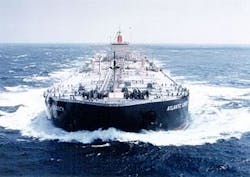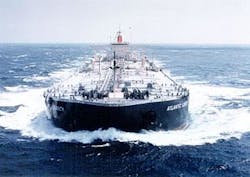Charter rates for oil tankers have hit historic highs around the globe, with Asian and European shippers reporting surges of income largely due to increased purchases of crude on the world's spot market (see sidebar).
Continuing high demand, together with a phasing out of single-hull tankers, has also led to increased prices for the construction of new ships, giving rise to concerns that oil shipping could remain expensive for some time to come.
Freight rates
"With us charging our largest tankers out at $200,000/day, my only regret is only having 24 of them in the group," said Helmut Sohmen, chairman of Bergesen Worldwide Ltd., at an October conference in London.
In Italy, tanker owner Navigazione Montanari SPA reported a 48.1% increase in pretax profits to 31.4 million euros ($37.4 million) in the first 9 months of the year from 21.2 million euros in the first three quarters of 2003.
null
The improvement was due to several factors, Montanari said, but largely it was because of "the average increase of market freight rates in both tankers and gas sectors."
Sweden's Broström AB, which also reported increased profits for the first 9 months, said the fourth quarter had started with a strong freight market in all its shipping segments, including oil.
The Göteborg-based firm says the increased requirements for quality and the focus in the oil industry on the "just-in-time" concept—combined with the consequent low oil stocks in Europe and the US—are expected to contribute to further positive development for Broström.
Broström also said high oil prices had led to a lack of interest in building up traditional stocks and that oil levels continue at an historic low. As a result, the low levels have led to "the increased demands for 'just in time' deliveries to avoid disturbances in the power supply."
Broström said, "...rates for the long-term employment of quality tonnage, on so-called time-charters, increased during the third quarter...and the fourth quarter has begun with a strong freight market."
Asian shippers also report a surge in income due to the spot market and high demand for ships. In Japan, the newspaper Nihon Keizai Shimbun (Nikkei) reported that freight rates are rising amid a tightening supply of ships, with spot freight rates for oil tankers shooting up to levels last seen during the oil crises of the 1970s. The newspaper said the cost of chartering a 250,000-ton tanker now runs at about $9.3 million, triple the amount earlier this year, due to increased oil demand in the US, China, and India.
Tanker rates have been boosted especially by Chinese importers who generally procure oil on the spot market instead of through long-term contracts, Nikkei said.
The high shipping rates also are reflected in China itself, where the net profit at China Shipping Development Co. Ltd. (CSD), the mainland's largest shipper of oil, soared 64% in the third quarter to $55 million.
CSD's earnings were largely driven in the first half of the year when its net profits grew by more than 92.6%, with an 18% rise in cargo volume. CSD's third-quarter growth slowed to 2% due to the opening of the Ningbo-Shanghai-Nanjing crude oil pipeline in May. But the slowdown in volume growth was more than offset by the higher freight rates.
In the shipment of foreign trade oil, its largest business segment, CSD said it raised the freight rate according to "the international spot market."
High
Japan's three largest shipping lines—Nippon Yusen KK, Mitsui OSK Lines Ltd., and Kawasaki Kisen Kaisha Ltd.—reportedly plan to spend a combined $28 billion by fiscal 2009 to buy new vessels. They are not alone in wanting to capitalize on a demand industry. But building new ships also could be increasingly expensive, given current demand.
According to Broström, the market for most shipping segments has been relatively high for some time. This, combined with the regulatory phasing out of single-hulled tonnage, has filled the shipyard's order books.
As a result, prices for newbuildings have risen, and in some cases it can now be difficult to sign new orders at acceptable terms.
Prices for second-hand quality tonnage have followed the same trend and have in some instances been quoted at higher than offered newbuilding prices due, according to Broström, to "the prevailing situation in the freight market."

